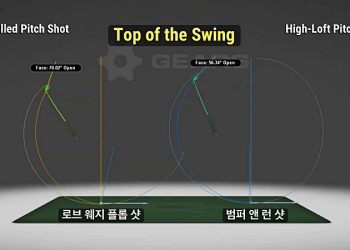프로 골퍼들의 벙커샷은 볼과 모래를 같은 곳으로 보낸다. 아마추어들은 이런 벙커샷의 기본 원리를 이해하면 실수를 많이 줄일 수 있다. 이를 위해 꼭 하지 말아야 할 몇 가지가 있다.
첫째 헤드가 볼에 직접 닿으면 안 된다는 것이다. 마치 모래가 볼과 클럽 페이스 사이에 있는 것처럼 느껴야 한다. 볼이 클럽 페이스와 닿는 소리가 나면 안 된다. 즉 스매시 팩터가 1보다 작아야 한다. 직접 닿게 되면 볼은 빠르게 날아가고 결국 그린을 넘기게 된다.
방법은 볼과 클럽 사이에 모래층을 두는 것이다. 이는 기본 골프 샷과 다르지 않다. 다만 모래를 퍼내고 볼은 모래를 따라가는 것이라 보면 된다.
일반적인 샷은 임팩트 순간 리딩 엣지가 볼 또는 지면에 먼저 접촉된다. 하지만 벙커샷은 페이스가 위로 열린 상태에서 바운스로 샷을 하게 된다. 실제로 벙커샷은 클럽 헤드의 바운스 뒷부분까지 이용해서 샷을 한다.
벙커샷에서 꼭 알아야 할 용어가 있다. 슬라이딩 이팩트(sliding effect)다. 이것은 클럽 헤드가 볼의 전후에 길게 미끄러지듯이 이동하는 원리를 말한다. 이를 이용해서 클럽 헤드가 진행되는 쪽으로 볼을 보내야 한다. 많은 경우 벙커샷을 할 때, 볼과 클럽헤드가 너무 가파르게 만난다.
두 번째 하지 말아야 할 것은 벙커샷의 금지조항이다. 벙커샷의 기본은 스탠스에서 출발한다. 일반적인 피치샷을 친다는 느낌의 스탠스를 취하고, 볼의 위치만 왼쪽에 놓이도록 전체적인 자세를 오른쪽 이동시킨다. 다음 클럽 페이스를 돌려 위쪽으로 열어 놓은 상태에서 양손을 낮게 내려놓는다. 클럽 사프트의라이각을 낮게 가져가는 것이 목적이다. 이어 각을 숙인 채 상체를 유지한다. 자세를 낮게 유지하기 위해서 상체를 더 숙일 필요는 없다. 그 자세를 유지하면서 양 무릎만 좀 더 굽힌다.
볼 뒤 10cm쯤에 흔적을 만든다. 같은 길이로 목표 방향 쪽에도 작은 흔적을 표시한다. 이제 벙커샷을 할 때 볼 앞뒤에 표시된 영역 안에서 헤드가 길게 진행되도록 한다. 벙커샷 후에 볼 앞뒤로 흔적을 길게 만드는 것이 바로 슬라이딩 이팩트다. 샷 후에 흔적을 자세히 보면, 모래가 날아간 방향을 볼 수 있다. 그 방향을 따라 볼도 날아간 것을 알 수 있다.
클럽 페이스를 연다 해서 스탠스의 방향을 수정하지 않아도 된다. 즉 정상적인 샷을 벙커샷에 적용한 원리에 적용한 것이다. 벙커의 모래를 볼과 같은 방향으로 날려 보내는, 단순한 원리다.
이렇게도 연습을 해 보자. 먼저 두 개의 볼을 벙커에 놓아둔다. 간격은 살짝 유지한다. 다음 2개의 볼을 함께 치면서 샷을 한다. 이렇게 해보면 확실히 원리를 알 수 있다. 모래를 핀 방향으로 보낸다는 느낌으로 슬라이딩 이팩트를 좀 더 길게 가져간다. 하나의 볼을 칠 때 느낌처럼 볼은 핀 방향으로 쉽게 탈출한다.
이 원리를 3개의 볼에도 적용시켜 보자. 같은 원리로 샷을 하되 다만 슬라이딩 이팩트 구간을 더 길게 가져간다. 모래를 보내는 방향은 같다. 볼을 1개, 2개, 3개를 칠 때도 모두 같은 원리를 적용한다.
성공적인 벙커샷을 위해서는 클럽 헤드의 리딩 엣지가 아닌 헤드의 바닥면을 이용한다. 즉, 바운스로 샷을 해야 한다. 좀 더 깊이 들어가면 바운스의 뒷부분까지 모래 면에 닿는 느낌으로 가져간다. 길게 가져가게 되면 볼의 벙커 탈출은 그만큼 더 쉬워진다. 벙커샷의 자신감은 성공으로 연결된다.
☞ 전욱휴는…
골프 칼럼니스트. PGA 클래스A 멤버이자 공인 티칭 및 코칭 강사다. SBS, MBC, JTBC, YTN 등의 골프 채널에서 진행자 및 해설자로 활약했다. 현재 애틀랜타에서 골프 레슨 및 골프 관련 비즈니스를 하고 있다. chungolf@gmail.com
Eric Chun’s Golf Lesson 12. Understanding the Basics of Bunker Shots to Minimize Mistakes
“The secret to bunker shots lies in the sliding effect.”
Professional golfers manage to send both the ball and sand to the same target. Understanding the fundamentals of bunker shots can significantly reduce mistakes. To comprehend the principles of a bunker shot, there are a few critical things you must avoid.
• The first thing to avoid is allowing the club head to come into direct contact with the ball. It should feel as if the sand is positioned between the ball and the clubface. There should be no sound of the ball hitting the clubface, meaning the smash factor should be less than 1. If direct contact occurs, the ball will fly quickly and overshoot the green.
The key to executing a bunker shot is to have a layer of sand between the ball and the club. It’s not too different from a basic golf shot; you’re simply scooping the sand and letting the ball follow.
In a standard shot, the leading edge of the club contacts the ball or ground first at impact. However, in a bunker shot, the face of the club should be open, allowing for a bounce shot. In reality, you use even the back portion of the club’s bounce during a bunker shot.
A crucial term to know for bunker shots is the “sliding effect.” This principle involves the club head moving smoothly before and after the ball, sending it in the direction the club head is moving. Often, golfers mistakenly let the ball and club head come into contact too sharply. Avoiding this is another essential rule for successful bunker shots.
A fundamental bunker shot starts with your stance. Take a stance as if you’re preparing for a pitch shot. Without changing your stance, shift your overall body position to the right so that the ball is placed to the left.
With the clubface turned open upwards, place your hands low. The goal here is to lower the lie angle of the club shaft. Maintain the angle of your bent-over upper body. To keep a low posture, bend only your knees a bit more.
Make a mark about 10 cm behind the ball. Use the same distance to make a small mark in the target direction. When taking the bunker shot, ensure the club head moves smoothly within the marked area before and after the ball. The elongated marks made by the club head indicate the sliding effect. Observing these marks after the shot shows the direction in which the sand—and consequently, the ball—flies.
You don’t need to adjust your stance even if the clubface is open. This applies the principles of a regular shot to a bunker shot. Effectively, it involves sending the sand and the ball in the same direction: a simple principle of bunker shots.
Place two balls a small distance apart in the bunker. Execute the shot by hitting both balls at the same time to grasp the principle. The sliding effect should be extended longer while aiming to send the sand toward the pin. Just like hitting one ball, this principle allows the ball to easily escape toward the pin. Apply the same principle when hitting three balls, elongating the sliding effect zone. Whether with one, two, or three balls, the principle remains the same: they all head towards the target.
For consistent success in bunker shots, use the club head’s bounce, not the leading edge. To delve deeper, ensure the back part of the bounce makes contact with the sand. The longer the bounce is used, the easier it becomes to escape the bunker. Confidence in your bunker shots will lead to successful outcomes.




![[전욱휴의 골프레슨] 12. 벙커샷의 기본 원리](https://www.atlantajoongang.com/wp-content/uploads/2024/06/collage-3-750x563.jpg)

















![[전욱휴의 골프 레슨] 46. 배치기(얼리 익스텐션)](https://www.atlantajoongang.com/wp-content/uploads/2025/03/photoKakaoTalk_20250306_073237889_01-350x250.jpg?v=1741361116)
![[전욱휴의 골프 레슨] 45. 임성재 '행온페이드' 샷](https://www.atlantajoongang.com/wp-content/uploads/2025/02/collage1-350x250.jpg)
![[전욱휴의 골프레슨] 44. 일관된 샷을 원한다면](https://www.atlantajoongang.com/wp-content/uploads/2025/02/QKakaoTalk_20250212_065748485-350x250.jpg)

![[전욱휴 골프 레슨] 42. 오른쪽 팔꿈치 역할](https://www.atlantajoongang.com/wp-content/uploads/2025/01/qQ1KakaoTalk_20250130_072058648-350x250.jpg)
![[전욱휴의 골프 레슨] 41. 매킬로이 파워 스윙](https://www.atlantajoongang.com/wp-content/uploads/2025/01/qQ1KakaoTalk_20250122_123635940-350x250.jpg)
